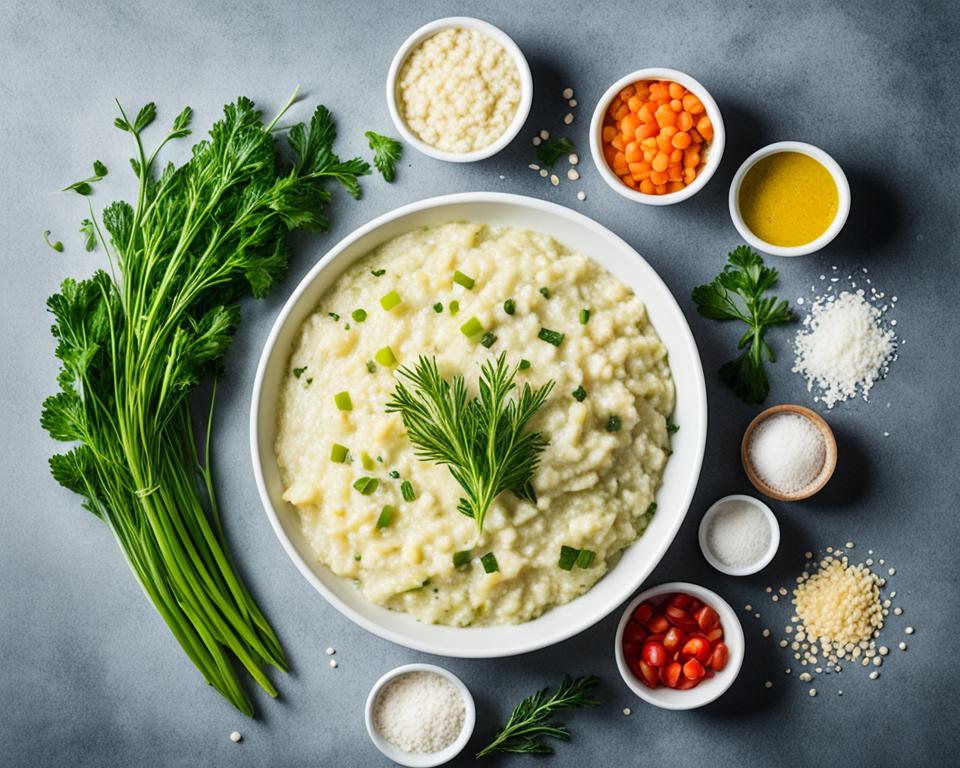Welcome to our guide on how to make a delicious and creamy homemade risotto. Whether you’re new to cooking or a seasoned chef, this easy risotto recipe will have you enjoying a comforting dish in no time. So grab your apron and let’s get started!
Key Takeaways:
- Learn how to make a creamy and flavorful risotto from scratch.
- Discover the essential ingredients needed for a perfectly creamy consistency.
- Follow step-by-step instructions for cooking risotto like a pro.
- Explore tips and tricks for making the perfect risotto every time.
- Find out about delicious variations and serving suggestions.
What is Risotto?
Risotto is a traditional northern Italian rice dish that is cooked to a creamy consistency. This delicious rice dish is made by cooking Arborio or other starchy rice varieties in a flavorful broth made from meat, fish, or vegetables. The slow and gradual addition of broth, along with constant stirring, helps release the starch from the rice, creating a creamy texture. The key to a good risotto lies in using the right type of rice, which absorbs flavors well and gives the dish its characteristic creamy consistency.
The versatility of risotto allows for endless flavor combinations. It can be customized with various ingredients such as proteins, vegetables, herbs, and spices, allowing you to create your own unique twist on this classic dish. Whether you prefer a simple risotto with just a few ingredients or a more complex version bursting with flavors, the creamy and comforting nature of this rice dish is sure to leave you satisfied.
Key Points:
- Risotto is a traditional northern Italian rice dish.
- It is cooked to a creamy consistency.
- Risotto is made by cooking rice in a broth made from meat, fish, or vegetables.
- The right type of rice, such as Arborio, is essential for achieving the creamy texture.
- Customize risotto with various ingredients to create different flavor combinations.
Ingredients for Creamy Risotto
To make a delicious and creamy risotto, you’ll need a carefully selected list of ingredients. Here are the key components that will bring out the rich and savory flavors in your dish:
- Chicken Stock or Vegetable Stock: This forms the flavorful base of your risotto. Choose chicken stock for a traditional taste or vegetable stock for a vegetarian version.
- Arborio Rice: The star of the show, Arborio rice is essential for achieving a creamy texture. Its high starch content ensures a velvety consistency in every bite.
- Onion: A finely chopped onion adds a subtle sweetness and depth of flavor to your risotto.
- Olive Oil: Use a good quality olive oil to sauté the onion and coat the grains of rice, enhancing the overall taste.
- Salt: A pinch of salt brings out the natural flavors of the ingredients and seasons your risotto perfectly.
- Butter: Creaminess comes from the addition of butter. It adds richness and a silky texture to your risotto.
- Grated Parmesan Cheese: The nutty and tangy flavor of Parmesan cheese complements the creaminess of the risotto, providing depth and complexity.
- Fresh Parsley: Finely chopped fresh parsley adds a pop of freshness and vibrant green color, elevating the overall presentation of your dish.
- Optional – White Wine: For additional flavor, you can include white wine in your risotto. It adds a subtle acidity that enhances the taste profile, but it is entirely optional.
Now that you have gathered your creamy risotto ingredients, it’s time to embark on a gastronomic journey and create a dish that will impress your taste buds.
| Ingredient | Quantity |
|---|---|
| Chicken Stock (or Vegetable Stock) | 4 cups |
| Arborio Rice | 1 ½ cups |
| Onion, finely chopped | 1 medium |
| Olive Oil | 2 tablespoons |
| Salt | 1 teaspoon |
| Butter | 2 tablespoons |
| Grated Parmesan Cheese | ½ cup |
| Fresh Parsley, finely chopped | 2 tablespoons |
| Optional – White Wine | ½ cup |
Step-by-Step Instructions for Making Creamy Risotto
Follow these step-by-step instructions to make your own creamy risotto at home.
- Prepare the Ingredients: Gather all the necessary ingredients for your homemade risotto. This includes chicken stock (or vegetable stock), Arborio rice, onion, olive oil, salt, butter, grated Parmesan cheese, and fresh parsley. Optional ingredients include white wine and additional toppings like mushrooms or shrimp.
- Saute the Onion: In a large saucepan, heat some olive oil over medium heat. Add finely chopped onion and saute until translucent. This will create a flavorful base for your risotto.
- Add the Rice: Add Arborio rice to the saucepan and stir it well, ensuring that each grain is coated with the oil. Toast the rice for a minute or two, allowing it to absorb the flavors from the onion and oil.
- Deglaze with Wine: If desired, pour in a splash of white wine to deglaze the pan. Stir the rice continuously until the wine has evaporated.
- Start Adding the Stock: Begin adding the warm chicken or vegetable stock to the saucepan, one ladle at a time. Stir the rice frequently to release its starch and create a creamy consistency. Allow the stock to fully absorb before adding the next ladleful. Continue this process until the rice is cooked, but still al dente.
- Finish with Creaminess: Once the rice is cooked to your desired consistency, remove the saucepan from heat. Stir in a knob of butter and grated Parmesan cheese, adding richness and creaminess to the risotto. Season with salt to taste.
- Serve and Garnish: Plate your homemade creamy risotto and garnish it with fresh parsley. You can also add any additional toppings or ingredients, such as sautéed mushrooms or cooked shrimp, to enhance the flavors.
| Step | Description |
|---|---|
| 1 | Prepare the Ingredients |
| 2 | Saute the Onion |
| 3 | Add the Rice |
| 4 | Deglaze with Wine |
| 5 | Start Adding the Stock |
| 6 | Finish with Creaminess |
| 7 | Serve and Garnish |
Tips for Making Perfect Creamy Risotto
Making risotto that is perfectly creamy and full of flavor can be a culinary challenge. But with the right tips and techniques, you can achieve risotto perfection every time. Here are some expert tips to help you cook risotto to perfection:
- Choose the right rice: When making risotto, it’s essential to use the right type of rice. Arborio rice is the most commonly used variety, as it has a high starch content that contributes to the creamy texture of the dish.
- Prepare your ingredients: Before you begin cooking, make sure to chop all your ingredients and have them ready to go. Risotto requires constant attention, so having everything prepped in advance will make the process much smoother.
- Start with a good base: Begin by sautéing onions or shallots in butter or olive oil until they are translucent. This creates a flavorful base for your risotto.
- Add the rice: Once the onions are cooked, add the rice to the pan and stir it to coat each grain with the butter or oil. This helps to toast the rice slightly and enhances its nutty flavor.
- Simmer slowly: When adding liquid to the rice, do it gradually and stir constantly. This slow simmering process allows the rice to absorb the flavors of the broth and develop its creamy consistency.
- Use warm broth: It’s important to use warm broth when cooking risotto. Adding cold broth can lower the temperature of the rice, making it harder to cook evenly.
- Don’t rush: Patience is key when making risotto. Avoid turning up the heat or rushing the cooking process. Risotto requires gentle and gradual cooking to achieve that perfectly creamy texture.
- Finish with butter and cheese: When your risotto is almost done, stir in a generous amount of butter and grated Parmesan cheese. This adds richness and a velvety texture to the finished dish.
- Let it rest: After cooking, let your risotto rest for a few minutes before serving. This allows the flavors to meld together and the dish to settle, resulting in a more cohesive and delicious final product.
“Making risotto is a labor of love. It requires patience and attention to detail, but the reward is a dish that is rich, creamy, and full of flavor.” – Chef Alessandro Rossi
By following these tips, you’ll be able to make risotto that is consistently creamy, flavorful, and absolutely perfect. Experiment with different ingredients and variations to create your own signature risotto dishes. Enjoy the process of cooking this classic Italian dish, and savor every delicious bite!
Substitutions and Variations for Creamy Risotto
While the classic creamy risotto recipe is delicious on its own, you can also make substitutions and variations to suit your taste. Here are some ideas:
1. Risotto Substitutions
If you don’t have some of the ingredients or want to try something different, you can make the following substitutions:
| Ingredient | Substitution |
|---|---|
| Arborio rice | Carnaroli rice or short-grain rice |
| Chicken stock | Vegetable stock or mushroom stock for a vegetarian option |
| Onion | Shallots or leeks |
| Parmesan cheese | Pecorino Romano or Grana Padano |
2. Variations of Risotto
Take your creamy risotto to the next level by adding different ingredients and flavors. Here are some variations to try:
- Wild Mushroom Risotto: Sautee a mix of wild mushrooms like porcini, chanterelles, and shiitake before adding them to the risotto.
- Asparagus and Lemon Risotto: Blanch asparagus spears and add them to the risotto along with lemon zest and juice for a fresh and vibrant flavor.
- Seafood Risotto: Incorporate cooked shrimp, scallops, and diced fish fillets into the risotto for a delightful seafood twist.
- Butternut Squash Risotto: Roast cubes of butternut squash and mix them into the risotto along with a sprinkle of cinnamon for a warm and comforting version.
These are just a few examples, but feel free to get creative and experiment with different ingredients and flavors to create your own unique risotto combinations.

Risotto Serving Suggestions
Risotto is a versatile dish that can be served as a side or as a main course. Whether you’re looking for accompaniments to enhance the flavors of your creamy risotto or want to turn it into a satisfying meal on its own, we have some delicious serving suggestions for you.
Side Dishes with Risotto
Pairing your risotto with the right side dishes can take your meal to the next level. Here are some options to consider:
- Grilled Vegetables: Serve your creamy risotto alongside a medley of grilled vegetables like zucchini, bell peppers, and eggplant.
- Garden Salad: A crisp and refreshing salad with fresh greens, cherry tomatoes, and a tangy vinaigrette is the perfect contrast to the richness of risotto.
- Roasted Chicken: Add some protein to your meal by serving roasted chicken alongside your risotto. The tender chicken pairs well with the creamy texture of the risotto.
Main Dishes with Risotto
If you want to turn your risotto into a satisfying main course, consider these options:
- Seared Scallops: Top your risotto with perfectly seared scallops for a luxurious seafood dinner.
- Mushroom Marsala: Add sautéed mushrooms with a splash of Marsala wine to your risotto for a flavorful vegetarian main course.
- Braised Short Ribs: Tender braised short ribs make a hearty and delicious pairing with creamy risotto.
Get creative with your serving suggestions and experiment with different flavors and combinations to suit your taste. Risotto is a versatile dish that can be customized to your liking, and the possibilities are endless!
Risotto Storage and Reheating Tips
While risotto is best enjoyed fresh, there may be occasions where you have some leftovers that you don’t want to go to waste. To ensure that your risotto stays flavorful and maintains its creamy texture, follow these tips for storing and reheating:
Storing Risotto:
1. Let it cool: Allow your risotto to cool down to room temperature before storing it. This helps prevent bacterial growth.
2. Choose the right container: Store your risotto in an airtight container to maintain its freshness. This will also prevent any odors or flavors from seeping in.
3. Refrigerate promptly: Place the airtight container in the refrigerator within two hours of cooking the risotto. Keeping it cold will slow down the growth of bacteria.
4. Label and date: It’s a good practice to label the container with the date, so you can easily keep track of how long the risotto has been stored.
Reheating Risotto:
1. Use the stovetop or microwave: You can reheat risotto either on the stovetop or in the microwave, depending on your preference and convenience.
2. Add liquid: Risotto tends to dry out when reheated, so add a splash of broth or water to rehydrate it. This will also help restore the creamy consistency.
3. Heat gently: To prevent scorching or uneven heating, warm the risotto slowly over low to medium heat. Stir it occasionally to ensure even distribution of heat.
4. Taste and adjust: Once reheated, taste the risotto and adjust the seasoning if needed. You may need to add a bit more salt, pepper, or Parmesan cheese to enhance the flavors.
Remember, reheated risotto won’t have the exact same texture as freshly cooked risotto, but with proper storage and gentle reheating, you can still enjoy a delicious meal. Just be mindful not to reheat it too many times, as the quality may deteriorate with each reheating cycle.
“Storing and reheating risotto properly can help you extend the enjoyment of your delicious homemade dish.” – Our Risotto Experts
Tips for Storing and Reheating Risotto:
- Cool the risotto before storing it
- Use an airtight container for storage
- Refrigerate the risotto promptly
- Add a splash of liquid when reheating
- Reheat the risotto gently and stir occasionally
- Taste and adjust the seasoning after reheating
By following these tips, you can ensure that your leftover risotto stays delicious and enjoyable even after being stored and reheated.
| Storing Risotto | Reheating Risotto |
|---|---|
| Let it cool Choose the right container Refrigerate promptly Label and date |
Use stovetop or microwave Add liquid Heat gently Taste and adjust |
Frequently Asked Questions about Risotto
At this point, you may have some common questions about making risotto. Don’t worry, we’ve got you covered! Below, we’ve answered some frequently asked questions and provided helpful tips to ensure your risotto-making experience is a success.
1. How do I know when the risotto is done?
Cooking risotto is all about achieving the perfect balance between creamy and al dente. To determine if your risotto is done, taste a grain of rice. It should be tender with a slight bite. Remember, the rice will continue to cook even after you turn off the heat, so be cautious not to overcook it.
2. Can I use a different type of rice?
While Arborio rice is the traditional choice for risotto, you can experiment with other medium-grain rice varieties like Carnaroli or Vialone Nano. These rice types have a similar starch content, resulting in a creamy risotto.
3. Can I make risotto without wine?
Yes, you can make risotto without wine. Wine adds depth of flavor, but if you prefer a non-alcoholic version or don’t have wine on hand, you can skip it. Just be sure to compensate by using more flavorful ingredients like a rich stock or herbs and spices.
4. How do I prevent my risotto from sticking to the pan?
Stirring the risotto frequently while it cooks will help prevent it from sticking to the pan. Additionally, using a non-stick pan or a heavy-bottomed pot can make the stirring process easier and reduce the chances of sticking.
5. Can I reheat leftover risotto?
Absolutely! To reheat leftover risotto, add a splash of liquid (such as stock or water) to the pan and heat it gently over medium-low heat. Stir the risotto continuously until it reaches the desired temperature. This will help revive the creamy texture and prevent it from becoming dry.
Quick Tip: Leftover risotto can also be transformed into delicious arancini (risotto balls) by shaping and frying them until golden brown.
6. How long can I store leftover risotto?
Stored in an airtight container in the refrigerator, leftover risotto can typically be kept for up to 3 days. Be sure to cool the risotto quickly after cooking and refrigerate it promptly to maintain its quality.
Now that we’ve answered some common questions about risotto, you’ll be well-equipped to prepare this delectable dish with confidence!
Creamy Risotto Recipe Video Tutorial
For those who prefer a visual guide, we have created a step-by-step video tutorial on how to make creamy risotto. In this tutorial, you will find additional guidance and expert tips to help you create the perfect risotto every time.
Follow along as our experienced chef demonstrates the techniques and methods for achieving the creamy consistency that makes risotto so irresistible. Learn the secrets to cooking the rice just right, incorporating the flavorful ingredients, and achieving the desired texture.
In the video tutorial, you’ll discover how to:
- Properly sauté the onions and rice for a flavorful base
- Add the broth gradually to achieve the creamy consistency
- Incorporate delicious ingredients like sautéed mushrooms, asparagus, or roasted butternut squash for added flavor and variety
- Finish off the risotto with a generous amount of grated Parmesan cheese
Whether you’re a beginner or an experienced cook, our video tutorial will help you master the art of making creamy risotto. Watch and learn at your own pace, and refer back to the tutorial whenever you need a refresher.
Check out the video tutorial below:
Additional Tips and Tricks for Perfect Risotto
Mastering the art of making risotto takes practice, but with these additional tips and tricks, you’ll be able to elevate your risotto cooking skills to the next level:
- Use the right rice: Choose high-starch rice varieties like Arborio, Carnaroli, or Vialone Nano. These types of rice will release more starch while cooking, helping to create that creamy texture we all love.
- Toast the rice: Before adding the liquid, toast the rice in butter or olive oil over medium heat for a few minutes. This step adds a depth of flavor to your risotto.
- Warm the broth: Keep your broth warm in a separate pot while making risotto. Adding cold broth to the hot rice can disrupt the cooking process and result in unevenly cooked grains.
- Stir consistently: Stirring the rice constantly while adding the broth helps release the starch and creates a creamy consistency. Don’t rush this step; it’s key to achieving the perfect texture.
- Add broth gradually: Add the broth to the rice gradually, allowing it to be absorbed before adding more. This helps ensure each grain of rice cooks evenly.
- Sauté the vegetables separately: If you’re adding vegetables to your risotto, sauté them separately before adding them to the rice. This ensures they’re cooked to perfection and retains their distinct flavors.
- Season properly: Taste your risotto as you go and adjust the seasoning accordingly. Remember, the broth, cheese, and other ingredients also add saltiness, so be mindful when adding additional salt.
- Finish with butter and cheese: For that extra touch of richness, stir in a pat of butter and a generous amount of grated Parmesan cheese right before serving. This enhances the flavor and adds a luxurious creaminess.
With these tips and tricks, you’ll be able to create risotto that rivals that of your favorite Italian restaurant. So roll up your sleeves, gather your ingredients, and let’s get cooking!
Conclusion
Making creamy risotto at home is a rewarding experience that anyone can enjoy. Whether you’re a seasoned chef or a beginner in the kitchen, with the right ingredients and a little patience, you can create a delicious and comforting dish that will impress your family and friends. The process of making risotto is not only about the end result, but also about the journey.
Experimenting with different variations and flavors is part of the fun. You can add your favorite proteins like shrimp, chicken, or mushrooms, and incorporate vegetables like peas, asparagus, or butternut squash. The possibilities are endless, and each variation will bring unique flavors to your risotto.
So, savor every creamy bite of your homemade risotto. Take the time to stir the rice and watch it absorb the flavorful broth. Enjoy the process and the aroma that fills your kitchen. With each perfectly cooked grain of rice, you’ll feel accomplished, knowing that you have mastered the art of creating a restaurant-worthy dish in the comfort of your own home.
FAQ
What is risotto?
Risotto is a traditional northern Italian rice dish that is cooked to a creamy consistency. It is made by cooking rice in a broth, which can be made from meat, fish, or vegetables.
What ingredients do I need to make creamy risotto?
To make creamy risotto, you will need chicken stock (or vegetable stock for a vegetarian version), Arborio rice, onion, olive oil, salt, butter, grated Parmesan cheese, and fresh parsley. Optional ingredients include white wine for additional flavor.
How do I make creamy risotto?
Follow these step-by-step instructions: Sauté onions in olive oil, add rice and cook until translucent. Gradually add warm broth, stirring continuously. Cook until rice is al dente, then stir in butter, Parmesan cheese, and parsley until creamy.
What are some tips for making perfect creamy risotto?
Some tips include using the right type of rice, adding warm broth gradually, stirring continuously, and cooking until the rice is al dente.
Can I make substitutions or variations to the risotto recipe?
Yes, you can customize your risotto by adding different proteins, vegetables, or other flavors to create unique combinations.
How should I serve creamy risotto?
Creamy risotto can be served as a side dish or as a main course. It pairs well with a variety of proteins, vegetables, or salads.
How do I store and reheat leftover risotto?
To store leftover risotto, cool it quickly and transfer it to an airtight container in the refrigerator. To reheat, add a little broth or water and heat it on the stove or in the microwave until warm.
What are some common questions about risotto?
Common questions include how to prevent the risotto from sticking, how long it takes to cook risotto, and how to achieve a creamy texture.
Where can I find a video tutorial for making creamy risotto?
You can find a step-by-step video tutorial on our website, which will provide additional guidance and tips for creating the perfect risotto.
Are there any additional tips and tricks for perfecting risotto?
Yes, some additional tips include using homemade broth for a richer flavor, adding ingredients at the right time for optimal cooking, and adjusting the seasonings according to your taste.





